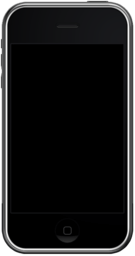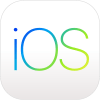iPhone (1st generation)
|
| |
 | |
| Developer | Apple Inc. |
|---|---|
| Manufacturer | Foxconn (contract manufacturer)[1] |
| Slogan |
"This is only the beginning." "Apple reinvents the phone." |
| Generation | 1st |
| Model | A1203[2] |
| First released | June 29, 2007 |
| Discontinued | July 15, 2008 |
| Units sold | 6.1 million |
| Successor | iPhone 3G |
| Related | iPad, iPod Touch (comparison) |
| Type | Smartphone |
| Form factor | Slate |
| Dimensions |
115 mm (4.5 in) H 61 mm (2.4 in) W 11.6 mm (0.46 in) D |
| Weight | 135 g (4.8 oz) |
| Operating system |
Original: iPhone OS 1.0 Current: iPhone OS 3.1.3 Released February 2, 2010 |
| CPU |
Samsung 32-bit RISC ARM 1176JZ(F)-S v1.0[3] 620 MHz Underclocked to 412 MHz[4] |
| GPU | PowerVR MBX Lite 3D GPU[5] |
| Memory | 128 MB eDRAM[6] |
| Storage | 4, 8 or 16 GB flash memory |
| Battery | 3.7 V 1400 mAh Lithium-ion battery[7] |
| Data inputs |
Multi-touch touchscreen display 3-axis accelerometer Proximity sensor Ambient light sensor Microphone Headset controls |
| Display |
3.5-inch screen (diagonally) 320×480 pixel resolution at 163 ppi 2:3 aspect ratio 18-bit (262,144-color) LCD |
| Rear camera | 2.0 MP with geotagging (Not GPS based) |
| Sound |
Single loudspeaker TRRS headphone jack, 20 Hz to 20 kHz frequency response (internal, headset) Microphone |
| Connectivity |
Quad-band GSM/GPRS/EDGE |
| Website |
www |
The iPhone is the first smartphone model designed and marketed by Apple. It is the first generation of iPhone that was announced on January 9, 2007 after years of rumors and speculation.[9]
It was introduced in the United States on June 29, 2007, and it featured quad-band GSM cellular connectivity with GPRS and EDGE support for data transfer.
On June 9, 2008, Apple announced its successor, the iPhone 3G. The original iPhone has not received software updates from Apple after iPhone OS (now iOS) 3.1.3.
Since June 11, 2013, the original iPhone has been considered "obsolete" in Apple retail stores, "vintage" by other service providers in the US, and "obsolete" in all other regions.[10] Apple does not service vintage or obsolete products, and replacement parts for obsolete products are not available to service providers.
History
In 2005, Apple CEO Steve Jobs conceived an idea of using a multi-touch touchscreen to interact with a computer in a way in which he could type directly onto the display, essentially removing the physical keyboard and mouse, the same as a tablet computer. Jobs recruited a group of Apple engineers to investigate the idea as a side project.[11] When Jobs reviewed the prototype and its user interface, he conceived a second idea of implementing the technology onto a mobile phone.[12] The whole effort was called Project Purple 2 and began in 2005.[13]
Apple created the device during a secretive and unprecedented collaboration with AT&T, formerly Cingular Wireless. The development cost of the collaboration was estimated to have been $150 million[14] over a thirty-month period. Apple rejected the "design by committee" approach that had yielded the Motorola ROKR E1, a largely unsuccessful collaboration with Motorola. Instead, Cingular Wireless gave Apple the liberty to develop the iPhone's hardware and software in-house.[15][16]
The original iPhone was introduced by Steve Jobs on January 9, 2007 in a keynote address at the Macworld Conference & Expo held in Moscone West in San Francisco, California.[17] In his address, Jobs said, "I have been looking forward to this for two and a half years", and that "today, Apple is going to reinvent the phone."[18] Jobs introduced the iPhone as a combination of three devices: a "widescreen iPod with touch controls"; a "revolutionary mobile phone"; and a "breakthrough Internet communicator".[19]
Release
The iPhone was released on June 29, 2007 in the United States where thousands of people were reported to have waited outside Apple and AT&T retail stores days before the device's launch;[20] with many stores reporting stock shortages within an hour. To avoid repeating the problems of the PlayStation 3 launch, which caused burglaries and even a shooting, off-duty police officers were hired to guard stores overnight.[21]
It was later made available in the United Kingdom, France, Germany, Portugal, the Republic of Ireland and Austria in November 2007.
Six out of ten Americans surveyed said they knew the iPhone was coming before its release.[22]
Post-release
The iPod Touch, a touchscreen device with the media and internet abilities and interface of the iPhone, but without the ability to connect to a cellular network for phone functions or internet access, was released on September 5, 2007. At the same time, Apple significantly dropped the price of the 8 GB model (from $599 to $399, still requiring a 2-year contract with AT&T) while discontinuing the 4 GB model.[23] Apple sold the one millionth iPhone five days later, or 74 days after the release.[24] After receiving "hundreds of emails...upset" about the price drop, Apple gave store credit to early adopters.[25]
A 16 GB model was released on February 5, 2008.[26] Apple released an SDK on March 6, 2008, allowing developers to create the apps that would be available starting in iPhone OS version 2.0, a free upgrade for iPhone users. On June 9, Apple announced the iPhone 3G, which began shipping July 11.[27] The original iPhone was discontinued 4 days later; total sales volume came to 6,124,000 units.
While most Apple literature simply called the device "iPhone," the term "the original iPhone" appears in a press release from July 2010.[28]
Software
During release, the iPhone was marketed as running "OS X". The name of the operating system was revealed as iPhone OS with the release of the iPhone SDK. The original iPhone supports three major versions: iPhone OS 1, 2, and 3. But it did not support the entire iPhone OS 3 and thus the last update it got was the iPhone OS 3.1.3
Software history
The original operating system for the original iPhone was iPhone OS 1, marketed as OS X, and included Visual Voicemail, multi-touch gestures, HTML email, Safari web browser, threaded text messaging, and YouTube. However, many features like MMS, apps, and copy and paste were not supported at release, leading hackers jailbreaking their iPhones to add these features. Official software updates slowly added these features.
iPhone OS 2 was released on July 11, 2008, at about the same time as the release of the iPhone 3G, and introduced third-party applications, Microsoft Exchange support, push e-mail, and other enhancements.
iPhone OS 3 was released on June 17, 2009, and introduced copy and paste, Spotlight search for the Home Screen, and new YouTube features. This version of OS updated the software of the original iPhone as well as the iPhone 3G; however, not all features of iPhone OS 3.0 were supported on the original iPhone.
iPhone OS 3.1.3 was the last version of iPhone OS (now iOS) to be released for the original iPhone.
Reception
The New York Times and The Wall Street Journal published positive, but cautious, reviews of the iPhone, their primary criticisms being the relatively slow speed of the AT&T's 2.5G EDGE network and the phone's inability to connect using 3G services. The Wall Street Journal's technology columnist, Walt Mossberg, concluded that "despite some flaws and feature omissions, the iPhone is, on balance, a beautiful and breakthrough handheld computer."[29] Time magazine named it the Invention of the Year in 2007.[30]
Timeline of models

See also
References
- ↑ Dalrymple, Jim (July 28, 2009). "iPhone manufacturer to pay family of dead worker". CNET. Retrieved April 6, 2010.
- ↑ "Identify your iPhone model". Apple Inc.
- ↑ Patterson, Blake (July 7, 2008). "Under the Hood: The iPhone's Gaming Mettle". touchArcade. Retrieved March 20, 2009.
- ↑ Dilger, Daniel Eran (March 20, 2008). "iPhone 2.0 SDK: Video Games to Rival Nintendo DS, Sony PSP". RoughlyDrafted Magazine. Retrieved May 12, 2009.
- ↑ Clarke, Peter (July 6, 2007). "Update: UK graphics specialist confirms iPhone design win". EE Times. pp. 1–2. Retrieved June 20, 2009.
- ↑ "Apple (Samsung S5L8900) applications processor with eDRAM". SUBM TechInsights. Retrieved May 12, 2009.
- ↑ "iPod and iPhone Battery and Power Specifications must be kidding me goofy". iPodBatteryFAQ.com. Retrieved May 12, 2009.
- ↑ "iPhone – Tech Specs". Apple; Wayback machine. July 14, 2007. Archived from the original on July 14, 2007. Retrieved January 19, 2009.
- ↑ Dolan, Brian. "Timeline of Apple "iPhone" Rumors (1999–Present)". Retrieved February 17, 2008.
- ↑
- ↑ Cohen, Peter (January 9, 2007). "Macworld Expo Keynote Live Update". Macworld. Retrieved February 1, 2007.
- ↑ Walter Mossberg; Kara Swisher (June 2, 2010). D8: Steve Jobs on the iPhone's Origin. All Things Digital. Event occurs at 0:20. Retrieved June 20, 2010.
- ↑ Murtazin, Eldar (June 20, 2010). "Apple's Phone: From 1980s' Sketches to iPhone. Part 3". Mobile-review. Retrieved March 27, 2011.
- ↑ Vogelstein, Fred (January 9, 2008). "The Untold Story: How the iPhone Blew Up the Wireless Industry". Wired News. Condé Nast Publications. pp. 3–4. Retrieved January 10, 2008.
- ↑ Lewis, Peter (January 12, 2007). "How Apple kept its iPhone secrets". CNNMoney.com. Retrieved January 11, 2009.
- ↑ Vogelstein, Fred (January 9, 2008). "The Untold Story: How the iPhone Blew Up the Wireless Industry". Wired News. Condé Nast Publications. pp. 1–4. Retrieved January 10, 2008.
- ↑ Cohen, Peter (March 13, 2007). "Macworld Expo Keynote Live Update". Macworld. Retrieved July 21, 2010.
- ↑ Farber, Dan (January 9, 2007). "Jobs: Today Apple is going to reinvent the phone". ZDNet "Between the Lines" blog. Retrieved June 20, 2010.
- ↑ Jobs, Steve (January 19, 2007). Macworld San Francisco 2007 Keynote Address. San Francisco: Apple, Inc.
- ↑ "Apple Inc. Q3 2007 Unaudited Summary Data" (PDF). Apple Inc. July 25, 2007. Retrieved June 6, 2008.
- ↑ Hart, Kim; Valle Sabrina (June 30, 2007). "Macworld Expo Keynote Live Update". The Washington Post. Retrieved February 1, 2007.
- ↑ Johnson, Bobbie (June 30, 2007). "iPhone causes big Apple swarm in Big Apple storms". The Guardian. London. Retrieved February 1, 2007.
- ↑ "Apple Sets iPhone Price at $399 for this Holiday Season". Apple. Retrieved June 21, 2010.
- ↑ "Apple Sells One Millionth iPhone". Apple. Retrieved June 21, 2010.
- ↑ Jobs, Steve. "To all iPhone customers:". Apple. Archived from the original on September 8, 2007.
- ↑ "Apple Adds New iPhone & iPod touch Models". Apple. Retrieved June 21, 2010.
- ↑ "Apple Introduces the New iPhone 3G". Apple. Retrieved June 21, 2010.
- ↑ "Statement by Apple on iPhone 4 reception issues". Apple. July 2, 2010. Retrieved July 2, 2010.
- ↑ "iPhone rush despite mixed reviews". The Australian. July 3, 2007. Retrieved February 1, 2007.
- ↑ Grossman, Lev (October 31, 2007). "Invention Of the Year: The iPhone". Time. Retrieved June 6, 2008.
- ↑ Apple Inc. (2004-2016). Press Release Library. Retrieved April 6, 2016.
External links
| Wikimedia Commons has media related to iPhone (original). |
- iPhone – official site
| New creation | iPhone 1st generation |
Succeeded by iPhone 3G |

